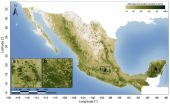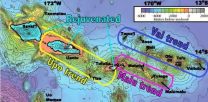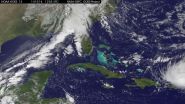(Press-News.org) A group of researchers led by Melina Bersten of the Kavli Institute for the Physics and Mathematics of the Universe recently presented a model that provides the first characterization of the progenitor for a hydrogen-deficient supernova. Their model predicts that a bright hot star, which is the binary companion to an exploding object, remains after the explosion. To verify their theory, the group secured observation time with the Hubble Space Telescope (HST) to search for such a remaining star. Their findings, which are reported in the October 2014 issue of The Astronomical Journal, have important implications for the evolution of massive stars.
For years astronomers have searched for the elusive progenitors of hydrogen-deficient stellar explosions without success. However, this changed in June 2013 with the appearance of supernova iPTF13bvn and the subsequent detection of an object at the same location in archival images obtained before the explosion using the HST. The interpretation of the observed object is controversial. The team led by Bersten presented a self-consistent picture using models of supernova brightness and progenitor evolution. In their picture, the more massive star in a binary system explodes after transferring mass to its companion.
One of the challenges in astrophysics is identifying which star produces which supernova. This is particularly problematic for supernovae without hydrogen, which are called Types Ib or Ic, because the progenitors have yet to be detected directly.
However, the ultimate question is: "How do progenitor stars remove their hydrogen-rich envelopes during their evolution?" Two competing mechanisms have been proposed. One hypothesizes that a strong wind produced by a very massive star blows the outer hydrogen layers, while the other suggests that a gravitationally bound binary companion star removes the outer layers. The latter case does not require a very massive star. Because these two scenarios predict vastly different progenitor stars, direct detection of the progenitor for this type of supernova can provide definitive clues about the preferred evolutionary path.
When young Type Ib supernova iPTF13bvn was discovered in nearby spiral galaxy NGC 5806, astronomers hoped to find its progenitor. Inspecting the available HST images did indeed reveal an object, providing optimism that the first hydrogen-free supernova progenitor would at last be identified. Due to the object's blue hue, it was initially suggested that the object was a very hot, very massive, evolved star with a compact structure, called a "Wolf-Rayet" star. (Using models of such stars, a group based in Geneva was able to reproduce the brightness and color of the pre-explosion object with a Wolf-Rayet star that was born with over 30 times the mass of the Sun and died with 11 times the solar mass.)
"Based on such suggestions, we decided to check if such a massive star is consistent with the supernova brightness evolution," says Melina Bersten. However, the results are inconsistent with a Wolf-Rayet star; the exploding star must have been merely four times the mass of the Sun, which is much smaller than a Wolf-Rayet star. "If the mass was this low and the supernova lacked hydrogen, our immediate conclusion is that the progenitor was part of a binary system," adds Bersten.
Because the problem requires a more elaborate solution, the team set out to simulate the evolution of a binary system with mass transfer in order to determine a configuration that can explain all the observational evidence (a blue pre-explosion object with a relatively low mass devoid of hydrogen). "We tested several configurations and came up with a family of possible solutions," explains Omar Benvenuto of IALP, Argentina. "Interestingly, the mass transfer process dictates the observational properties of the exploding star, so it allows suitable solutions to be derived even if the mass of the stars is varied," adds Benvenuto. The team chose the case where two stars are born with 20 and 19 times the mass of the Sun. The mass transfer process causes the larger star to retain only four times the solar mass before exploding. Most importantly, the smaller star may trap part of the transferred mass, becoming a very bright and hot star.
The existence of a hot star would provide strong evidence for the binary model presented by Bersten and collaborators. Fortunately, such a prediction can be directly tested once the supernova fades because the hot companion should become evident. "We have requested and obtained observation time with the HST to search for the companion star in 2015," comments Gaston Folatelli of Kavli IPMU. "Until then, we must wait patiently to see if we can identify the progenitor of a hydrogen-free supernova for the first time," Bersten adds.
INFORMATION:
Peering through a giant cosmic magnifying glass, NASA's Hubble Space Telescope has spotted a tiny, faint galaxy -- one of the farthest galaxies ever seen. The diminutive object is estimated to be more than 13 billion light-years away.
This galaxy offers a peek back to the very early formative years of the universe and may just be the tip of the iceberg.
"This galaxy is an example of what is suspected to be an abundant, underlying population of extremely small, faint objects that existed about 500 million years after the big bang, the beginning of the universe," explained ...
NASA is carrying out its sixth consecutive year of Operation IceBridge research flights over Antarctica to study changes in the continent's ice sheet, glaciers and sea ice. This year's airborne campaign, which began its first flight Thursday morning, will revisit a section of the Antarctic ice sheet that recently was found to be in irreversible decline.
For the next several weeks, researchers will fly aboard NASA's DC-8 research aircraft out of Punta Arenas, Chile. This year also marks the return to western Antarctica following 2013's campaign based at the National Science ...
NASA's Interface Region Imaging Spectrograph (IRIS) has provided scientists with five new findings into how the sun's atmosphere, or corona, is heated far hotter than its surface, what causes the sun's constant outflow of particles called the solar wind, and what mechanisms accelerate particles that power solar flares.
The new information will help researchers better understand how our nearest star transfers energy through its atmosphere and track the dynamic solar activity that can impact technological infrastructure in space and on Earth. Details of the findings appear ...
Parasitic bacteria were the first cousins of the mitochondria that power cells in animals and plants – and first acted as energy parasites in those cells before becoming beneficial, according to a new University of Virginia study that used next-generation DNA sequencing technologies to decode the genomes of 18 bacteria that are close relatives of mitochondria.
The study appears this week in the online journal PLOS One, published by the Public Library of Science. It provides an alternative theory to two current theories of how simple bacterial cells were swallowed ...
The need for food, animal feed and fuel in the Sahel belt is growing year on year, but supply is not increasing at the same rate. New figures from 22 countries indicate falling availability of resources per capita and a continued risk of famine in areas with low 'primary production' from plants. Rising temperatures present an alarming prospect, according to a study from Lund University in Sweden.
The research has investigated developments between the years 2000 and 2010 in the Sahel belt, south of the Sahara Desert. Over this ten-year period, the population of the region ...
Cold Spring Harbor, NY – How many times have we seen Superman swoop down from the heavens and rescue a would-be victim from a rapidly oncoming train?
It's a familiar scenario, played out hundreds of times in the movies. But the dramatic scene is reenacted in real life every time a cell divides. In order for division to occur, our genetic material must be faithfully replicated by a highly complicated machine, whose parts are tiny enough to navigate among the strands of the double helix.
The problem is that our DNA is constantly in use, with other molecular machines ...
Available for download today, the Woods Hole Research Center (WHRC) and Allianza MREDD+ released the first detailed map of aboveground forest carbon stocks of Mexico. This carbon stock inventory is very valuable for Mexico, as one of the first tropical nations to voluntarily pledge to mitigation actions within the context of the United Nation's Reducing Emissions from Deforestation and forest Degradation (REDD+) program.
The hectare-scale map is the result of a collaboration led by WHRC scientists Josef Kellndorfer and Oliver Cartus with Mexico's National Forestry Commission ...
1. Conventional medical centers may be unable to prevent spread of Ebola
A group of infectious disease experts suggests that conventional U.S. medical centers are unprepared and ill equipped to manage Ebola and a national network of specialized containment and treatment facilities may be needed to reduce the virus' spread, according to an article being published in Annals of Internal Medicine. Despite efforts from the Centers for Disease Control and Prevention (CDC) to prepare hospitals for Ebola, enormous challenges remain. The authors express doubt that conventional ...
A UC Santa Barbara geochemist studying Samoan volcanoes has found evidence of the planet's early formation still trapped inside the Earth. Known as hotspots, volcanic island chains such as Samoa can ancient primordial signatures from the early solar system that have somehow survived billions of years.
Matthew Jackson, an associate professor in UCSB's Department of Earth Science, and colleagues utilized high-precision lead and helium isotope measurements to unravel the chemical composition and geometry of the deep mantle plume feeding Samoa's volcanoes. Their findings ...
VIDEO:
NOAA's GOES-East satellite captured this image of Hurricane Gonzalo off the U.S. East Coast on Oct. 16 at 13:07 UTC (9:07 a.m. EDT).
Click here for more information.
NASA and NOAA satellites have been providing continuous coverage of Hurricane Gonzalo as it moves toward Bermuda. NASA's Terra satellite saw thunderstorms wrapped tightly around the center with large bands of thunderstorms wrapping into it. NOAA's GOES-East satellite provided and "eye-opening" view of Gonzalo, ...







